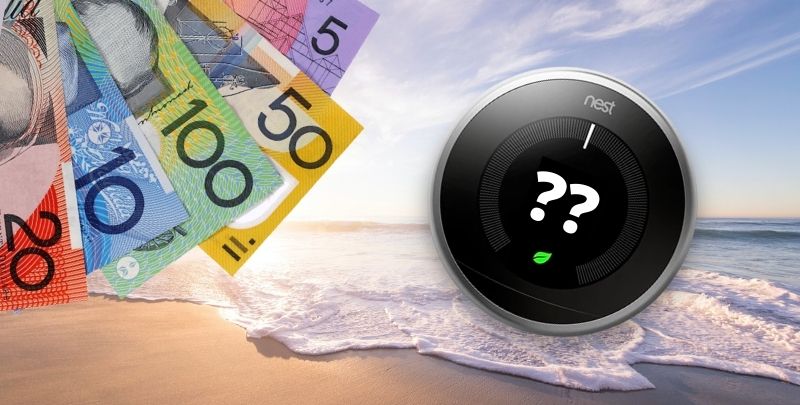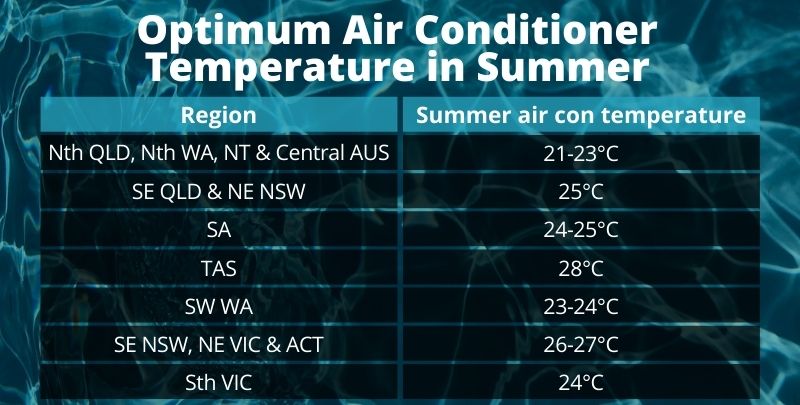
What Temperature Should I Set My Air Conditioner in Summer?
With the return of short sleeves and office thermostat debates, summer has certainly made its grand return. Did you know that heating and cooling in the home accounts for a whopping 20% to 50% of your energy bill though?
Setting your air conditioner to the optimal temperature can make a big difference in its running costs over the summer months. We’re here to tell you exactly what the ideal air conditioner temperature is and what you can do to reach maximum energy efficiency without breaking a sweat.
What’s the Best AC Temperature for Summer?
As a general rule, the best temperature for your air conditioner in summer is 25-27°C. There are some caveats, however, namely that this assumes you live in a moderate climate.
We’re sure many of you would be hesitant to say Australian summers are “moderate”, so we’re going to break down the best temperature for air conditioning by different regions.

If you don’t know what temperature to set your air conditioner to, consider the following.
The real ideal temperature requires you to balance the climate of where you live and your comfort. People living in warmer climates such as North Queensland will typically need to set their air conditioning unit to 21-23°C to reach a comfortable temperature and maintain efficiency. Meanwhile, people in cooler regions such as Tasmania can set their systems to 28°C to keep cool.
As outdoor temperatures increase, your air conditioner will need to work harder to offset this and keep a comfortable indoor temperature. Temperature settings that are slightly higher than your usual air conditioning habits will have an impact on your air conditioner’s energy efficiency.
How Temperature Setting Affects Costs
The lower you set the temperature on your air conditioner in summer, the harder it has to work, and the more energy it will consume. More energy equals higher energy bills.
For every degree you decrease your air conditioner’s temperature, you add around 10% to its energy use. This might not sound like much, but it adds up on your energy bill in the end.
You can use the Ergon Air Conditioning Calculator to calculate your system’s approximate running costs based on the cooling capacity, temperature setting, and how much it is used.
For example, a 6.0kW air conditioner set to 21°C that runs for six hours a day over 12 weeks will cost you $191.75. Setting it to 25°C, however, could save you $59.16! It’s hard to say what the ideal air conditioning temperature is, but that kind of saving can’t be ignored.
Whether you’re in an oceanic climate or an arid climate, you will need to set your air conditioner accordingly.
Thankfully, there are extra things you can do to reduce your power bill and reach optimal performance with your air conditioning system.
How to Save Money on Your AC Bill
While you can’t entirely avoid a rise in your energy bills when you’re using air conditioning, you can minimise how much it increases.
We’ve got 6 easy ways you can make sure your air conditioner unit is energy efficient, beyond just the temperature settings.
1. Upgrade Your Insulation
Between 25 and 35% of the heat gained in your home during summer is through the ceiling. A further 15 to 25% comes through the walls and 25 to 35% through your windows.
The warmer it is inside your home, the harder your air con needs to work to cool it back down. Upgrading or renewing your home’s insulation can go a long way in keeping this heat out in the first place.
Fitting your roof space with batts or loose-fill foam can help to prevent unwanted heat from entering your home. Simply keeping your curtains shut when the sun is out can also help to keep the heat out. Bonus points if they’re insulated curtains.
2. Bigger Isn’t Always Better
If you’re looking at installing a new air conditioner, it’s important you get the right size to ensure maximum energy efficiency. A unit that’s too big will use more energy than would be necessary to cool your home to the set temperature.
Meanwhile, a unit that’s too small will work harder than a unit that’s the right size, resulting in parts wearing down sooner than they should.
As a general rule, here are the recommended air conditioner capacity based on room size:

This is for rooms with standard sized ceilings. If your ceilings are especially high, then you will need a bigger capacity to have the same cooling effect. All of these factors will affect your air conditioner’s performance.
3. Regularly Clean the Filters
Cleaning your air conditioner filters two to four times a year is one of the easiest ways to keep electricity costs down. These filters are there to prevent air pollution from entering your home, but over time will accumulate and form a buildup.
This buildup will worsen your home’s air quality as the filters are unable to do their job. It will also cause your air conditioner to work harder as it has to compete with the buildup, causing higher electricity bills.
4. Use Your Ceiling Fans
You can turn the cooling temperature up and reduce energy consumption by using your ceiling fans in combination with your air conditioner.
In summer mode, a ceiling fan will push cool air down and drag any warm air up and away from you. While not changing the temperature of the room, ceiling fans can help to make a room feel cooler.
This means you can adjust the temperature setting, increasing the temperature a little in order to use less energy.
5. Graduate to a Smart Thermostat
A smart thermostat can help to reach optimal efficiency with your cooling efforts. Most of us turn the air con on full as soon as we get home from work to get our home to the right temperature. This can blast through a lot of energy.
With a smart thermostat, you can turn your air conditioner on to a moderately cool temperature from your phone while still at work so when you get home it’s already nice and cool, without the big energy surge. That’s a handy piece of technology during our occasional heat waves.
You can set your air con to turn on when the thermostat reaches a certain temperature, or even set it to a timer. This kind of automation takes the thinking out of your home’s cooling and means you can cool it down more efficiently.
6. Use the Different Operating Modes
Most of us only use the heat and cool mode on our air conditioner, but modern units come with more features than just that. Two modes, in particular, can help to save energy when cooling your home – energy-saving mode and sleep mode.
The energy-saving mode does exactly as the name would suggest, increases the units energy efficiency. It won’t cool quite as effectively as it would in regular cooling mode, but if you turn the unit on early enough in the day this shouldn’t matter.
On those nights where it’s just too hot to turn the air con off, use the sleep mode. This mode will slowly increase the temperature to compensate for the decreasing temperature outside. This means the unit will use less energy as the night goes on.
Other Factors to Consider
Australia is hardly a mild temperate climate. Getting your air conditioner temperature right along with these extra tips is a sure-fire way to improve your system’s energy efficiency, reducing the cost of cooling your home during this summer’s heat waves.
There are many different factors to consider when cooling your home during summer. What is the ideal energy saving temperature for your home during the heat?
You might be living in a high humidity climate. In this case you will want to consider the amount of moisture in the air. How often do you get your air conditioner serviced? Air filters should be cleaned or replaced regularly, which will definitely affect the energy efficiency of your air conditioner unit.
Are you dealing with more internal body heat than the average person? If so, you should consider drinking cool liquids, using a damp cloth or taking a cool bath or shower, rather than turning down the AC too low.
These factors along with considering the general ambient temperature – whether you’re in the humidity of the north, the dry heat of Central Australia or cooler temperatures of Tasmania – will all have an impact on your energy costs.
If you’re looking to install a new air conditioner, need your current system repaired, or are just after an annual service, Metropolitan Air Conditioning has air con experts available today for a same-day service. Contact us today and we can have someone at your door within the hour*.
Please note: This information is provided for advice purposes only. Regulations differ from state to state, so please consult your local authorities or an industry professional before proceeding with any work. See our Terms & Conditions here.
Published: 2021-09-20

































